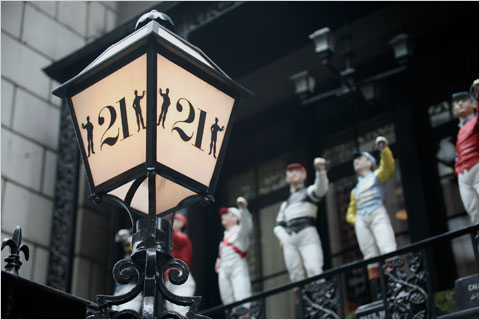UPDATE: Looks like Gallagher's, thankfully, is changing hands, not closing down. More to come.
*****
Now not even the stalwart steak houses are immune from the forced death march imposed upon New York's culinary and bibulous landmarks by cutthroat real estate values, a sunken economy and indifferent governing from City Hall.
Gallagher's Steak House, born in 1927, a child of the Roaring 20s, will
die on Jan. 16.
Up until now, New York's iconic steak houses have seemed fortified against a New York that no longer seems to care about its New Yorkiness. Peter Luger's, Old Homestead, Smith & Wollensky, Keen's—they all still stand. Such places have always been patronized by fat cats with big bankrolls. As long as such luxurious creatures of business (and their expanse accounts) exist, cow palaces such as these have no worries. Such was the assumption. But rhe death of Gallagher's represents a worrisome fissure in the chop house facade.
Gallagher's began its existence as a Theatre District speakeasy, patronized by show folk, sports figures writers and politicians. It was founded by Helen Gallagher, a former Ziegfeld girl who had been married to Ed Gallagher of the famous vaudeville team Gallagher and Sheen; and her second husband, gambler Jack Solomon. When Prohibition ended in 1933, it continued on, business as usual, without missing a beat. When Helen died in 1943, Solomon married showgirl and florist Irene Hayes. Solomon died in 1963, leaving Irene sole owner. Hayes then sold to Jerome Brody, who had been the head of Restaurant Associates, the famous corporation which owned such places as Four Seasons, La Fonda de Sol and The Forum of the Twelve Caesars.
To most New Yorkers, Gallagher's is most famous for its sidewalk display of its wares. Large windows look into meat lockers, where various cuts of red meat sit and/or hang, a tantalized (or revolting, depending on your inclination) taste of the hearty fare that awaits inside.
In 1942, when LaGuardia's City Hall imposed a voluntary "meatless Tuesday" policy on the city, Gallagher's didn't even try to adapt; it closed. A sign in the window said: "Okay, Uncle Sam! We'll cooperate to the letter. We'll ever go you one better. Tuesday is meatless and also is eatless, for we will be closed on Tuesdays." The steak house fought bitterly with the government throughout WWII over meat rationing.
Gallagher's has franchise branches in Newark, Atlantic City and Las Vegas.































